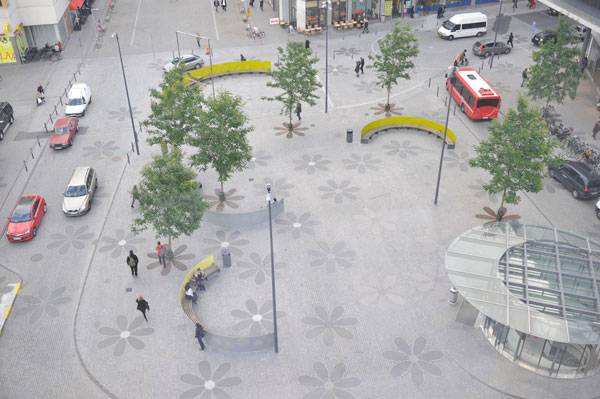Liljeholmstorget, by Nivå Landskapsarkitektur in Liljeholmen/Stockholm, Sweden. The famous Swedish film director Ingmar Bergman once said that Stockholm “is not a city at all. It is ridiculous of it to think of itself as a city. It is simply (a) rather larger village, set in the middle of some forests and some lakes.” – *Ingmar Bergman: An Artist’s Journey, by Roger W. Oliver The interview was given many years ago, but Bergman’s point of view still resonates in modern Sweden. Undoubtedly, the relationship between a vibrant city and nature is strong. One example is Liljeholmen, which is known for being the first suburb outside the Stockholm city limits. Liljeholmen was eventually incorporated into the capital city in 1913. Many offices, apartments, and industries are situated there. At first thought, we can probably perceive Liljeholmen as a strongly urbanized area. But as Bergman noted, “Stockholm seems always to have had the aspect of a village.” Moreover, the village is always identified with fresh air, greenery, and community integration. Is Liljeholmen that same kind of village?

Liljeholmstorget. Photo credit: Anders Karlen and Nivå
A Vibrant District in Need of a Public Square
Liljeholmen is situated in the southern part of Stockholm. It is known for its offices and factories. But new residential areas are being built around industrial sites (close to Årstaviken) and the central square. It is not fortunate that this area is under construction, since it is a part of several projects to enlarge the inner corner of the capital city. The project cannot be completed without green areas and meeting points. Which brings us to the public square called Liljeholmstorget, which was designed by Nivå Landskapsarkitektur and completed in 2011.

Liljeholmstorget. Photo credit: Anders Karlen and Nivå
The Pavement Focuses Attention
Liljeholmstorget is a great example of the historical tradition of the Stockholm school. With trees and benches, the square looks rather minimalistic. But the detail that makes its original and atypical is a patterned pavement. That part has become a fundamental feature of the public place.

Liljeholmstorget. Photo credit: Anders Karlen and Nivå

Liljeholmstorget. Photo credit: Anders Karlen and Nivå
The Major Challenge for Designers
One of the most significant questions is: What was the main challenge while designing the public square? We need to point out that this part of Liljeholmen is situated close to the bus station. Designers from Nivå Landskapsarkitektur had a difficult task: How to invite people to stay at the busy hub and transit at the same time? How to encourage them to come here and relax before they catch their bus? First and foremost, the typical solutions were rejected at the beginning; ordinary benches and trees were not suitable for the creative designers’ idea. Instead, the landscape architects proposed curved benches with intriguing perforations.

Liljeholmstorget. Photo credit: Anders Karlen and Nivå
Curved Benches for Meeting in the Square
Are the benches just a marvellous design or also an innovative idea? It is hard to deny that nothing is random at Liljeholmstorget. The main aim was to create an intimate room for meetings in the central part of the square. It was accessible by “curved screens”, which are in fact benches. They are turned in different directions, and holes inside the iron material catch the sun throughout the day. This provides great access to sunlight, even though the screens are rather tall. The benches’ simple shape without aggressive detail is emphasized by vibrant yellow color. The benches are noticeable from every point of the square. See More Great Projects in Sweden:
- A Dramatic Peninsula Setting Makes Way for a Reflective Park in Sweden
- How to Provide Easy Access to Urban Agriculture in Over Populated Cities
- Borås Textile Fashion Center Mark the Beginning of a new Phase in the Textiles Industry

Liljeholmstorget. Photo credit: Anders Karlen and Nivå

Liljeholmstorget. Photo credit: Anders Karlen and Nivå
The Flora Transforms the Square Throughout the Year
Liljeholmstorget contains a small number of different plants species, but what makes this square unique are definitely Robinias. Their lobed foliage gives pleasant shadow in the daytime. Moreover, they provide an exotic and light impression. The seasonal variations of the Robinia are known for transforming the square throughout the year — cheerful with green leaves in the spring and stunning with colorful foliage in the autumn. Moreover, in springtime the trees burst out in large, bright flower bunches. In the warmer months, the Robinias are complemented by summer flowers, perched in pots that were specially designed for the public square.

Liljeholmstorget. Photo credit: Anders Karlen and Nivå

Liljeholmstorget. Photo credit: Anders Karlen and Nivå

Liljeholmstorget. Photo credit: Anders Karlen and Nivå
Full Project Credits For Liljeholmstorget
Project Name: Liljeholmstorget Landscape Architect: Nivå Landskapsarkitektur Client: Stockholms stad Artist: Beatrice Hansson Lighting: Alteco Contractor: HIFAB AB Area: 8,500 sqm Location: Liljeholmen/Stockholm Opened: 2011 Photographs: Anders Karlen and Nivå Recommended Reading:
- Urban Design by Alex Krieger
- The Urban Design Handbook: Techniques and Working Methods (Second Edition) by Urban Design Associates
Article by Paulina Sawczuk Return to Homepage
Published in Blog










